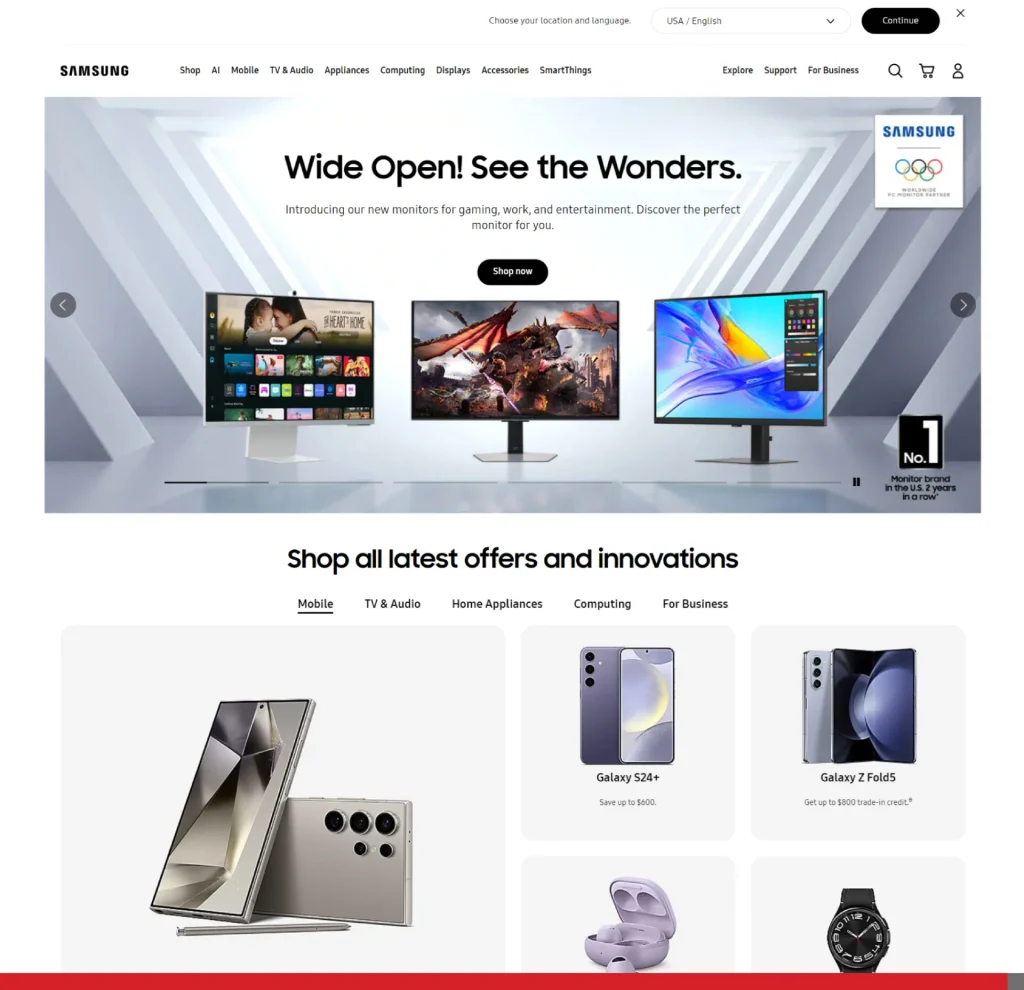The crossroads between User Experience (UX) and Search Engine Optimization (SEO) have become increasingly significant, and these two subjects are much more deeply connected than you might guess.
As search engines like Google continue to prioritize user satisfaction, understanding how UX influences both SEO and overall user behaviour and engagement is crucial for businesses aiming to improve their online visibility and performance.
It’s logical to assume that most websites should be built with visitors in mind, ensuring seamless user interaction.
This analysis explores the immediate relationship between website user experience and SEO, providing insights into how optimizing UX can lead to better search rankings and overall success in digital marketing.
- What is User Experience (UX)?
- What is SEO?
- Are They Connected?
- How UX Design Impacts SEO Performance?
- What Are the Key UX Elements that Enhance SEO Strategies?
- Case Studies and Real-World Examples: Virgin America and Samsung
- Strategies for Integrating UX and SEO
- Future Trends in UX and SEO

What is User Experience (UX)?
User Experience (or UX in short) refers to users’ overall interaction with a website, including site navigation, user interface design, content accessibility, and overall satisfaction.
It ensures that users can easily and efficiently find the information they need on the websites they visit, engage with content, and complete desired actions without frustration. Key elements of UX include:
- Page speed: Faster loading times improve user satisfaction and reduce bounce rates. Website speed is crucial as it directly impacts user satisfaction and engagement, influencing how users interact with the site.
- Navigation: Intuitive and easy-to-use navigation helps users find information quickly.
- (Clean) design: Aesthetic and functional design enhances user engagement and trust.
- Mobile responsiveness: Ensuring the website works well on all devices.
- User interaction: Enhancing user interaction through intuitive design and engaging content.
Sometimes UX is closely followed by UI in the wild, which refers to the user interface – or what we call the look of your website.
While UI is how a user interacts with your site, UX is how all the underlying layers are connected and presented to provide the best experience without leaving website users wondering how to perform specific actions within a website.
What is SEO?
One highly-discussed topic on EasyHosting is SEO. SEO stands for Search Engine Optimization (SEO), and it involves optimizing a website to rank higher in search engine results pages (SERPs). It’s important to understand why search engines favour certain websites and use that knowledge to improve your website’s design, appearance, and content.
Search Engine Assist, for instance, is one of EasyHosting’s web services for small businesses that analyzes your existing website’s on-page SEO and off-page SEO – helping the page to achieve better rankings.
Search engine algorithms monitor interactions with a website to gauge the type of user experience it offers. They measure factors such as fast page loading times, easy navigation, engaging and helpful content, and user engagement as indicators of a high-quality website that may be rewarded with improved rankings.
Things that affect SEO include:
- Keyword optimization: Writing content with the keywords your target audience will likely search for.
- Backlinks: Acquiring links from other reputable websites. Also called link-building.
- Content quality: Providing valuable, high-quality content that meets user intent.
- Technical SEO: Ensuring the website is crawlable and indexable by search engines.
Are They Connected?
While they have plenty of intersecting points, user experience and search engine optimization are different things.
The gist is that optimizing for user experience usually enhances SEO, while optimizing your website for search engines will not guarantee the greatest user experience.
Nevertheless, it’s crucial to balance your optimization efforts on both aspects so that you can reap the benefits of a successful business.

How UX Design Impacts SEO Performance?
The correlation between website user experience and search engine optimization is real and quite important. Understanding user behaviour through tools like heatmaps can provide insights into how users interact with your website, which in turn affects SEO performance.
UX metrics such as PageSpeed Insights from Google and plenty of other providers are a good starting point for figuring out how your website stands in terms of its SEO performance.
1. Page Speed and Core Web Vitals
Website speed is crucial for user experience and SEO, as Google considers site speed a critical ranking factor.
Website pages that are loading slowly lead to high bounce rates, negatively impacting SEO. Google’s Core Web Vitals, including LCP, INP, and CLS, which measure loading performance, interactivity, and visual stability, are essential components of UX that influence search rankings.
It’s recommended to use this tool in conjunction with other tools, such as Pingdom, to gain a better understanding of your site and pinpoint the causes of slow page speed.
Imagine visiting a website that shifts its content every few seconds, not allowing you to scroll or tap at a certain point on the screen. This hurts your user experience and could earn the page a lower rank on search engine results like Google Search.
In that case, optimizing your code and images will yield faster page load speed.
2. Mobile-Friendliness for Mobile Devices
With the majority of web traffic coming from mobile devices, Google has adopted mobile-first indexing, which means that a website must be optimized for mobile devices first before being optimized for anything else.
Websites that are not optimized for mobile use suffer in search rankings. Ensuring a seamless mobile experience is crucial for maintaining high SEO performance.
3. Navigation and Site Structure
A well-structured website with clear navigation improves user engagement and makes it easier for search engines to crawl and index content. Logical site architecture, with minimal click depth (the number of clicks required to reach a page from the homepage), enhances both UX and SEO.
4. Content Quality and Relevance
High-quality, relevant content is the cornerstone of both UX and SEO. Content that meets user intent keeps website visitors engaged longer, reducing bounce rates and signalling to search engines that the site is valuable.
Structured content with proper headings and multimedia elements also enhances user experience and search visibility. High-quality content improves visibility in search results, making it essential for better search rankings.

What Are the Key UX Elements that Enhance SEO Strategies?
When considering the key UX design elements that can improve your SEO, it’s important to include major components such as responsive designs, as well as often overlooked elements like URL structure.
Key UX elements that enhance SEO strategies:
- Responsive designs: Ensuring your website is accessible and functional on all devices.
- URL structure: Creating clean and descriptive URLs for better indexing.
- Website speed: Ensuring fast loading times to improve user satisfaction and SEO performance.
While these technical factors may go unnoticed, they can greatly contribute to reaching a broader audience through search engines.
1. Responsive Design
Responsive web design ensures that a website adapts to different screen sizes and devices. This improves usability and accessibility, which in turn positively affects SEO. Google prioritizes mobile-friendly websites, making responsive design a critical aspect of SEO strategy.
Most website designers typically use @media in CSS to specify the screen size of the device on which the content is being rendered. Some WordPress themes will have this baked into their code; however, when you’re working on your own website from scratch, you have to include these yourself.
Responsive web design is another critical part of website structure, and it will pave the way for small business success.
Finding it hard to make a website yourself?
Worry not, as EasyHosting’s Professional Website Design is here to help. Our highly trained website designers, copywriters, and quality assurance specialists are dedicated to delivering outstanding results for you.
2. User-Friendly URLs
Clean, descriptive URLs that include relevant keywords help both users and search engines understand the content of a page. User-friendly URLs improve click-through rates and enhance the overall user experience.
3. Interactive Elements and User Engagement Metrics
Interactive elements such as forms, buttons, and multimedia can enhance user engagement.
However, these elements must be optimized (to be enabled only when a user reaches the desired web page depth, for instance) to avoid slowing down the site or causing usability issues. Properly implemented interactive features contribute to a positive user experience and can boost SEO.
Evaluating the effectiveness of these elements can be done through user engagement metrics, which are crucial for understanding user behaviour and improving website quality.
4. Accessibility
Web accessibility ensures that all users, including those with disabilities, can navigate and interact with a website. Accessible design broadens the potential user base and complies with search engine guidelines, positively influencing SEO.
Case Studies and Real-World Examples: Virgin America and Samsung
After UX designers redesigned its website with a focus on UX principles, Virgin America saw a 14% increase in conversion rates, a 20% reduction in customer service calls, and faster booking times. This example highlights the tangible benefits of prioritizing UX in web design.
Samsung, one of the leading smartphone and appliance manufacturers, excels in providing a seamless user experience through its well-organized website.
The site offers easy access to all options, whether you’re looking to explore the product range, find upcoming releases, or seek assistance with a particular product. This user-friendly approach ensures an efficient and enjoyable user experience.

Strategies for Integrating UX and SEO
Integrating UX and SEO strategies not only enhances the overall user journey but also makes it easier for search engines to pick up your website and helps your page to stand out from the crowd in SERPs.
Conducting UX Audits
Regular UX audits help identify areas of improvement in site navigation, design, and content. These audits should consider all the user expectations, behaviour analytics, and performance metrics to ensure a comprehensive understanding of the user experience.
Additionally, understanding user behaviour through tools like heatmaps can provide insights into clicking, mouse movement, scrolling patterns, and interaction with website elements, which are crucial for improving engagement, site traffic, and search engine rankings.
Utilizing A/B Testing
A/B testing allows businesses to experiment with different design elements, content layouts, and interactive features to determine what works best for users. Continuous testing and iteration are key to maintaining an optimal user experience and improving SEO.
Focusing on User Intent
Understanding user intent is crucial for creating content that meets user needs. Keyword research should go beyond search volume and consider the context and purpose behind user queries. Content that aligns with user intent enhances both UX and SEO.
Future Trends in UX and SEO
Artificial Intelligence and Machine Learning
AI and machine learning are increasingly being used to personalize user experiences and improve search algorithms. For instance, tools like an AI image generator can elevate content creation by offering visually stunning and unique graphics tailored to specific audiences. Websites that leverage these technologies to provide personalized content and recommendations are likely to see improved SEO performance.
Voice Search Optimization
Imagine a future where you won’t need to search through a website to find what you’re looking for. Instead, you would simply click on a microphone icon and speak into your device’s microphone to search the web page.
Website owners are still figuring out how to optimize for voice search, which is currently most popular among mobile users.
With the rise of voice search and AI assistants worldwide, optimizing for natural language and conversational content is highly important. Using an AI Voice Generator can enhance user experience by creating engaging, human-like interactions that improve accessibility for voice assistant users.
Conclusion
The synergy between UX and SEO is undeniable. A well-designed user experience not only satisfies visitors but also meets the criteria set by search engines for high rankings.
By focusing on site speed, mobile-friendliness, intuitive navigation, high-quality content, and accessibility, businesses can enhance both UX and SEO. As digital landscapes continue to evolve, staying ahead of UX and SEO trends will be crucial for maintaining a competitive edge and achieving long-term success in online marketing.
Have a great business idea? Join EasyHosting to start your business today, stand out from the crowd with a professionally designed website, and get the tools you need to elevate your online presence!
Contact us at support@easyhosting.com
Οr call us at 1-888-390-1210 to find out more.



